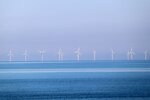06/21/2009
USA - US lagging in offshore wind energy?
Imagine a renewable energy source so large it can provide enough power for 750,000 homes, or a quarter of all homes in London, England, especially when the fuel is free. It's called the London Array and when built it will be the world's largest offshore wind farm.
The first phase of the project, announced May 12, is financed by the Danish utility DONG Energy, E.ON of Germany and Masdar of Abu Dhabi. The consortium is investing $3.1 billion to push ahead with the first phase of the 1,000-megawatt project this summer. The London Array when complete will use 278 of the Siemens 3.6-megawatt turbines that are to be manufactured in Denmark.
United Kingdom Prime Minister Gordon Brown said: "The London Array is a flagship project in our drive to cut emissions by 80 percent by 2050 and meet future energy needs. The U.K. is a world leader in offshore wind farms, creating jobs and prosperity for the economy." E.ON CEO Wulf Bernotat said: "Renewable power can be taken to its next level and make a real difference to the fight against climate change." Once compete it will displace the emission of 2 million tons of CO2 every year.
The U.K. has overtaken the lead from the Danes in the installation of offshore wind farms. Seven of the initial round one projects of modest size with 30 turbines each have been completed since 2003 in near-shore, shallow waters. Names reveal the location, like Scroby Sands, Kentish Flats and Burbo Bank, to name a few. Five more are nearing completion now, Lynn Skegness, Inner Dowsing, Rhyl Flats, Robin Rigg and Gunfleet Sands.
The more ambitious U.K. round two leases opened in 2003. These wind farms of 100 turbines or more are all in relatively shallow water using slender monopole foundations. Most are located within 12 miles of shore. Permits have been granted for the wind farms on Sheringham Shoal, Thanet, Greater Gabbard and Gwynty Mor.
Looking back, European dominance in wind technology started in Denmark after the 1973 oil embargo. At that time the Danes depended on oil for 90 percent of their electrical generation. "Never again" was their credo. Denmark built their first offshore wind farm at Vindeby in 1991. In a couple of years it will celebrate its 20th anniversary.
The Danes have taken the lead in worldwide wind turbine technology and manufacturing. One manufacturer, Vestas, produces a large wind turbine every three hours, 24 hours a day for the world market. Now, in addition to more than 4,000 land-based wind turbines, the Danes have built eight offshore wind farms on shallow water shoals. With names like Middelgrunden in Copenhagen's busy harbor, to Horns Rev and Nysted, the world's two largest offshore wind farms that are now being doubled in size, and the completely energy-independent Samsoe Island, the message is clear that shallow-water, near-shore wind farms are a mature technology.
Including Sweden, and the Netherlands, 18 offshore wind farms have been built in Europe since Cape Wind announced its plans for America's first offshore wind farm in 2001. Ten more are under construction and four additional projects have permits in place.
Offshore turbine manufacturing is dominated by Vestas in Denmark and Siemens of Germany which acquired the Danish manufacturer Bonus. Between them they have built and installed 546 offshore turbines to date. The Danish utility DONG Energy has just placed a blanket order for 500 of the Siemens 3.6-megawatt turbines (to be manufactured in Denmark) for its upcoming projects in northern Europe. This is the same class size turbine selected for the Cape Wind project.
Meanwhile here we sit with a privileged and powerful few fussing about the view. After eight exhausting years of numerous public hearings, tens of thousands of pages of research and substantiation, thorough reviews by 17 federal, state and local agencies, overcoming eight frivolous lawsuits and expenditures approaching $30 million, we anxiously await a permit decision from the federal government for Cape Wind. Hopefully we will see a favorable decision from Secretary of the Interior Ken Salazar before winter.
Just think of the manufacturing and employment opportunities here if we can open the American market for offshore wind. Vestas alone has over 20,000 employees. That's about half the size of the restructured General Motors. Those Danish wind turbines could and should be built here.
Cape Wind will be the beginning of reducing our dependence on foreign oil and natural gas that are the dominant fossil fuels for electrical generation in New England. Every megawatt-hour of wind power will eliminate the need to generate that same megawatt-hour from oil or natural gas. Overall it will avoid the emission of some 700,000 tons of carbon dioxide from those fossil fuels every year.
For more information please contact Trevor Sievert at ts@windfair.net
The first phase of the project, announced May 12, is financed by the Danish utility DONG Energy, E.ON of Germany and Masdar of Abu Dhabi. The consortium is investing $3.1 billion to push ahead with the first phase of the 1,000-megawatt project this summer. The London Array when complete will use 278 of the Siemens 3.6-megawatt turbines that are to be manufactured in Denmark.
United Kingdom Prime Minister Gordon Brown said: "The London Array is a flagship project in our drive to cut emissions by 80 percent by 2050 and meet future energy needs. The U.K. is a world leader in offshore wind farms, creating jobs and prosperity for the economy." E.ON CEO Wulf Bernotat said: "Renewable power can be taken to its next level and make a real difference to the fight against climate change." Once compete it will displace the emission of 2 million tons of CO2 every year.
The U.K. has overtaken the lead from the Danes in the installation of offshore wind farms. Seven of the initial round one projects of modest size with 30 turbines each have been completed since 2003 in near-shore, shallow waters. Names reveal the location, like Scroby Sands, Kentish Flats and Burbo Bank, to name a few. Five more are nearing completion now, Lynn Skegness, Inner Dowsing, Rhyl Flats, Robin Rigg and Gunfleet Sands.
The more ambitious U.K. round two leases opened in 2003. These wind farms of 100 turbines or more are all in relatively shallow water using slender monopole foundations. Most are located within 12 miles of shore. Permits have been granted for the wind farms on Sheringham Shoal, Thanet, Greater Gabbard and Gwynty Mor.
Looking back, European dominance in wind technology started in Denmark after the 1973 oil embargo. At that time the Danes depended on oil for 90 percent of their electrical generation. "Never again" was their credo. Denmark built their first offshore wind farm at Vindeby in 1991. In a couple of years it will celebrate its 20th anniversary.
The Danes have taken the lead in worldwide wind turbine technology and manufacturing. One manufacturer, Vestas, produces a large wind turbine every three hours, 24 hours a day for the world market. Now, in addition to more than 4,000 land-based wind turbines, the Danes have built eight offshore wind farms on shallow water shoals. With names like Middelgrunden in Copenhagen's busy harbor, to Horns Rev and Nysted, the world's two largest offshore wind farms that are now being doubled in size, and the completely energy-independent Samsoe Island, the message is clear that shallow-water, near-shore wind farms are a mature technology.
Including Sweden, and the Netherlands, 18 offshore wind farms have been built in Europe since Cape Wind announced its plans for America's first offshore wind farm in 2001. Ten more are under construction and four additional projects have permits in place.
Offshore turbine manufacturing is dominated by Vestas in Denmark and Siemens of Germany which acquired the Danish manufacturer Bonus. Between them they have built and installed 546 offshore turbines to date. The Danish utility DONG Energy has just placed a blanket order for 500 of the Siemens 3.6-megawatt turbines (to be manufactured in Denmark) for its upcoming projects in northern Europe. This is the same class size turbine selected for the Cape Wind project.
Meanwhile here we sit with a privileged and powerful few fussing about the view. After eight exhausting years of numerous public hearings, tens of thousands of pages of research and substantiation, thorough reviews by 17 federal, state and local agencies, overcoming eight frivolous lawsuits and expenditures approaching $30 million, we anxiously await a permit decision from the federal government for Cape Wind. Hopefully we will see a favorable decision from Secretary of the Interior Ken Salazar before winter.
Just think of the manufacturing and employment opportunities here if we can open the American market for offshore wind. Vestas alone has over 20,000 employees. That's about half the size of the restructured General Motors. Those Danish wind turbines could and should be built here.
Cape Wind will be the beginning of reducing our dependence on foreign oil and natural gas that are the dominant fossil fuels for electrical generation in New England. Every megawatt-hour of wind power will eliminate the need to generate that same megawatt-hour from oil or natural gas. Overall it will avoid the emission of some 700,000 tons of carbon dioxide from those fossil fuels every year.
For more information please contact Trevor Sievert at ts@windfair.net
- Source:
- Online editorial www.windfair.net
- Author:
- Posted by Trevor Sievert, Online Editorial Journaist
- Email:
- ts@windfair.net
- Link:
- www.windfair.net/...
- Keywords:
- wind energy, wind farm, renewable energy, wind power, wind turbine, rotorblade, offshore, onshore


























